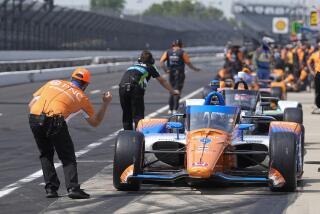The Spin Doctors : Flywheels Seen as Key to a Practical Electric Vehicle
- Share via
In the basin where the word smog was invented, alternative-fuel vehicles--particularly cars that store energy in flywheels--will be a center of attention at this year’s Los Angeles Auto Show, which opens Saturday.
Chrysler Corp. will show off its concept of a flywheel-assisted race car, which the company unveiled Wednesday in Detroit. And American Flywheel System, a small company based in Bellevue, Wash., will display a sedan that would run entirely on the energy-storage devices, called flywheel batteries.
The international push by auto makers to develop a practical electric car has been slowed by researchers’ difficulties in coming up with batteries able to replicate the driving features of gasoline-powered autos.
Proponents say high-tech flywheels, which store energy through the same ancient principle used in a potter’s wheel, could be used as a new battery to make electric cars a reality.
“There’s a lot going on lately in flywheels,” said Jim Birk, director of storage and renewables at the Electric Power Research Institute, which conducts research and development work for the major U.S. electric utilities.
One plus for flywheels in transportation uses: fast acceleration. “Flywheels have the characteristic of very fast response time,” Birk said. Another, according to Edward W. Furia, American Flywheel Systems chairman and chief executive, is their potential to greatly increase driving range.
Furia estimates that between charges, his flywheel car will be able to go more than three times the current 100-mile range of many of the best existing electric cars.
American Flywheel Systems “has some very interesting concepts,” said Philip C. Symons, manager of public transportation projects at EPRI, “but it remains to be proved that the performance required for electric vehicles can be achieved.”
American Flywheel developed its storage device with the manufacturer, Minneapolis-based Honeywell, which for three decades has built flywheels for the aerospace and defense industries.
The Chrysler car, called the Patriot, has a 500-horsepower liquid-natural-gas-burning turbine, but it uses the flywheel to store excess energy. Both the turbine and flywheel feed an electric motor that runs the race car at speeds of up to 200 m.p.h.
The Chrysler carbon-fiber flywheel is similar to that used in satellites. In the race car, it stores excess energy produced by the turbine and captures kinetic energy produced when the brakes are applied.
“Where is it written that a car that is ‘green’ cannot be red-hot with excitement,” Francois Castaing, Chrysler’s vice president of vehicle engineering, said in unveiling the car at the North American International Auto Show in Detroit.
The American Flywheel car and other attempts to harness flywheels as the main energy-storage device for a vehicle are aimed at meeting California’s zero-emission vehicle rules, which essentially require major auto makers to offer electric cars for sale in California showrooms beginning in 1998.
The race car project serves a dual purpose for Chrysler. It allows the company to re-enter big-time racing while placing a priority on research and development for the clean car of the future--including cars known as hybrids, which run on two fuels.
Hybrid vehicles are seen as promising, particularly by auto makers faced with the 1998 deadline, because the two sources of propulsion help extend vehicle range and performance. Auto makers have called for amending the California rules to achieve air pollution reductions without requiring electric cars. Though hybrids have low emissions, they would not meet California’s looming zero-emission standard.
Chrysler hopes to have a working model of its race car within several months and to decide within the year whether to proceed further. It hopes to be sanctioned by international and U.S. motor sports groups to compete in endurance races in a special class for cutting-edge vehicles.
Castaing said cars using such technology would probably not be ready for the market until well into the next century.
Other alternative-fuel vehicles at the Los Angeles show will include a Mitsubishi electric hybrid that claims a range of 310 miles in its battery-only mode, a Ford natural-gas version of its big Crown Victoria, and a Chrysler natural gas minivan that will be the first vehicle to be certified by the state Air Resources Board as an ultra-low-emissions vehicle.
There will also be a stubby, high-efficiency Mercedes-Benz “city car,” the first of a new class of Mercedes designed for extremely high efficiency in versions that use gasoline, diesel or electric batteries.
How Flywheel Batteries Work
Using the same ancient energy-storage principle that keeps a potter’s wheel or yo-yo turning, high-tech flywheels can be used to store electricity, much like a standard battery. Charging the battery with electricity increases the speed of the flywheel, up to 200,000 revolutions per minute. As electricity is drained from the battery to run an engine, the flywheel gradually slows down. Proponents say that modern, highly efficient flywheels--which spin in a vacuum on non-touching magnetic bearings--could power electric cars better than more traditional chemical batteries, giving up to three times the driving range.
The Wheel:
Small, speedy wheels made of tough composite materials store the energy.
Vacuum casing:
The wheel spins in a vacuum, to greatly lower resistance.
Magnetic bearings:
Because the same magnetic poles repel each other, magnets are used to suspend the wheel as it spins, without the friction of traditional bearings which physically touch.
Pickup coils:






